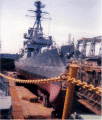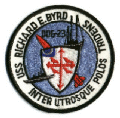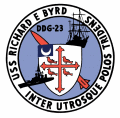Click On Image
For Full Size Image |
Size |
Image Description |
Contributed
By |

| 65k | Richard Evelyn Byrd, son of Richard E. and Eleanor Bolling Byrd and younger brother of Senator Harry Flood Byrd, Sr., was born in Winchester, Va., 25 October 1888. After graduating from the Naval Academy 7 June 1912. Byrd was assigned to battleship South Carolina (BB-26), and subsequently served in Kentucky (BB-6), Wyoming (BB-32), Missouri (BB-11), Washington (ACR-11), and Dolphin (PG-24). He was retired 15 March 1916 because of a leg injury. On 24 May 1916 he was recalled to active duty, limited service, and acted as Instructor-Inspector of Naval Militia, Providence, East Providence, Bristol, and Newport, R.I. After the United States entered World War I, he organized a commission on training camps. Following flight training at Pensacola, Fla., he was designated Naval Aviator No. 608 on 17 April 1918 and served during the remainder of World War I as Commanding Officer, U.S. Naval Air Stations in Canada. In planning and executing antisubmarine patrols, Byrd pioneered in night and all-weather flying, designed improved navigation instruments, and devised a plan for a transatlantic flight, which resulted in the NC-4 flight, the first crossing of the Atlantic by air. After studying in England at the Royal Air Force School of Aerial Navigation, Byrd helped to establish naval reserve air stations throughout the United States. In 1924 he was ordered to Washington for a proposed flight of the lighter-than-air craft Shenandoah (ZR-1) over the North Pole, but when the craft was damaged in a storm, the expedition was canceled. Byrd then turned his thoughts to flight over the North Pole by heavier-than-air craft. He obtained funds from private sources to pay for the expedition and borrowed equipment such as planes, tractors, and ships from government agencies. In the fall of 1925 Byrd's first story appeared in the National Geographic Magazine, beginning a valuable association with the National Geographic Society which continued over the next three decades. Byrd and Floyd Bennett took off from King's Bay, Spitzbergen, 750 miles from the Pole, 9 May 1926. After 7 hours of flight they were over the North Pole. Byrd, the first man to fly over the Pole, was second only to Peary to reach that point. In 1926 Byrd acquired an improved three engine Fokker and named it America, and prepared for a nonstop transatlantic flight to establish the feasibility of regular passenger service across the Atlantic. However, while bad luck delayed Byrd, Charles Lindbergh took off from New York on 20 May 1927 and landed at Paris 33 hours later. The America departed New York 29 June 1927, found Paris fogged in, and so landed in the ocean just off the French coast. Byrd and his three crewmen were rescued, taken to Paris, and then returned to an enthusiastic welcome in New York. Byrd's first Antarctic expedition, consisting of City of New York and Eleanor Bolling, departed the United States 28 August 1928; steamed via the Panama Canal and New Zealand; and, on 1 January 1929, established a base on the Bay of Whales, Antarctica, named Little America. Byrd and three companions took off from Little America 28 November 1929 in the ski-equipped trimotored monoplane, Floyd Bennett, and headed for the South Pole where they dropped an American flag. When Byrd returned to the United States, he was promoted to rear admiral. In 1933-35 he led a second expedition to Antarctica. Living at an advanced base to record weather data during the long winter night, Byrd nearly died from carbon monoxide. Although rescued in time, he suffered from the ill effects of the poisoning for the rest of his life. Byrd's third expedition consisted of the Navy commissioned and manned Bear (AG-29) and Department of the Interior's North Star. Two wintering over bases were established and scientific investigation was intensified. During World War II, Admiral Byrd studied and reported on their suitability for airfields. After the war ended, Byrd resumed polar exploration. During Operation "Highjump" he led an expedition of 4,700 men and modern support equipment in 13 ships to the Antarctic. They explored much of the little known continent and added greatly to man's knowledge of the region. In 1954 the Secretary of Defense agreed to furnish logistic support for American scientists in the Antarctic for the International Geophysical Year which would begin on 1 July 1957. President Eisenhower appointed Byrd, Officer-in-Charge of U.S. Antarctic programs. Admiral Byrd remained active in exploration of Antarctica until he died in his home at Boston on 11 March 1957. Photo courtesy of the Library of Congress. | Bill Gonyo. |

| 43k | Undated, location unknown. | - |

| 135k | Undated, location unknown. | - |

| 61k | Undated postcard Copyright © Atlantic Fleet Sales, Norfolk, VA. | Mike Smolinski |

| 178k | Undated, location unknown. | ssharpbt2 |

| 68k | Undated, location unknown. USS Richard E. Byrd (DDG-23), USS Dwight D. Eisenhower (CVN-69) and USS Wichita (AOR-1). | Ron Reeves |

| 129k | Undated, location unknown. | Richard Miller BMCS USNR RET. |

| 109k | Undated, location unknown. | Richard Miller BMCS USNR RET. |

| 133k | Undated, location unknown. | Richard Miller BMCS USNR RET. |

| 82k | Undated, location unknown. | Richard Miller BMCS USNR RET. |

| 57k | Undated, location unknown. | Richard Miller BMCS USNR RET. |

| 216k | Departing Genoa, Italy on May 14 1965. | Carlo Martinelli |

| 181k | Departing Genoa, Italy on May 14 1965. | Carlo Martinelli |

| 185k | Early 1966 in the Bosporus off Istanbul, USS Sampson (DDG-10) and USS Richard E. Byrd (DDG-23). | David Meare |

| 118k | USS Richard E. Byrd (DDG-23) at left; the attack aircraft carrier USS America (CVA-66), and the destroyer USS William R. Rush (DD-714) underway in 1967, location unknown. Photo taken by PH1 R. L. Campbell, United States Navy, Official. | Robert Hurst |

| 101k | USS Richard E. Byrd (DDG-23) underway in 1969, location unknown. United States Navy. | Robert Hurst |

| 108k | Circa 1972, location unknown. | Bill Gonyo |

| 50k | At Barcelona, Spain, in the summer of 1973. From left to right: the guided missile destroyer leader/frigate (later cruiser) USS Dale (DLG 19, later CG 19); the guided missile destroyers USS Conyngham (DDG 17) and USS Richard E. Byrd (DDG 23), the destroyer escort (later frigate) USS Elmer Montgomery (DE 1082, later FF 1082), and the destroyers USS Glennon (DD 840) and USS Sarsfield (DD 837). Photo by Isidoro Cenera. | Fabio Peña |

| 221k | Three views of the Byrd during the Arab - Israeli War in October 1973 in the Eastern part of the Mediterranian Sea. The Kennedy Battle Group formation of 12 ships southward of Gavdos Island, near Crete. The USS Richard E. Byrd was blocking attempts of the Soviet Kashin class DDG Krasny Krim to approach to the Kennedy. | Eugene Ivkin |

| 163k | As above. | Eugene Ivkin |

| 272k | As above. | Eugene Ivkin |







Welcome Aboard pamphlet - circa 1974 | Wolfgang Hechler |

| 55k | Circa 1977, location unknown. | Robert Hurst |

| 80k | Barcelona, Spain Oct. 25, 1978, bridge, with a triple Mk.32 torpedo tube mount and UNREP gear on the 01 level; a SATCOM antenna on the starboard side; ESM radomes on the mast platforms and an ECM antenna cantilevered out from the port side (just to the left of DesRon 2 crest). A Mk.68 gun director, with SPG-53 radar, sits atop the bridge. | Fabio Peña |

| 69k | Barcelona, Spain Oct. 25, 1978, foremast, the largest antenna is that of the SPS-40 air search radar, with a surface search SPS-10 just forward and slightly below of it and a TACAN radome aft and above. The mast is topped by a direction finder, and ESM radomes can be seen in platforms protruding from the mast. | Fabio Peña |

| 95k | Barcelona, Spain Oct. 25, 1978, the ASROC "pepperbox": the Mk.112 rocket launcher, mounted on the 01 level amidships, between the stacks. | Fabio Peña |

| 96k | Barcelona, Spain Oct. 25, 1978, from left to right: the black, rectangular antenna of the SPS-39 3D radar, mounted on the after stack; the dishes of the SPG-51 missile tracking and illuminating radars; the after 5"/54 Mk.42 gun mount, with its right "frog-eye" (for local anti-air control) removed; and the single-arm Mk.13 missile launcher. A SATCOM antenna is visible at the extreme left of the photo, below the SPS-39 and besides the SPG-51 pedestals. | Fabio Peña |

| 30k | This is a photo I took of the USS Richard E Byrd and the Kashin class destroyer Smelyy passing close during manuvers in the Baltic Sea in Nov. 1979. After I took the photo I ran to the radar repeater to see how close they came. It was between 500 and 1000 yards | Walter Bengtson |

| 58k | January 1 1983, Atlantic Ocean, an aerial starboard bow view of the guided missile destroyer USS Richard E. Byrd (DDG-23) underway. | Fred Weiss |

| 51k | October 4 1983, Norfolk VA, a view of the Mark 42 5-inch/54-caliber gunmount on the aft deck of the guided missile destroyer USS Richard E. Byrd (DDG 23). | Fred Weiss |

| 142k | DN-ST-84-01450. A view of the ASROC missile launcher amidships on the guided missile destroyer USS RICHARD E. BYRD (DDG-23), Norfolk. Photo by Don Montgomery October 4 1983. | Bill Gonyo |

| 108k | DN-ST-84-01464. A view of the radio receiver board in the combat information center aboard the guided missile destroyer USS RICHARD E. BYRD (DDG-23) whikle in Norfolk. Photo by Don Montgomery, October 4 1983. | Bill Gonyo |

| 49k | DN-ST-84-01456. A view of the Mark 13 Tarter missile launcher aboard the guided missile destroyer USS RICHARD E. BYRD (DDG 23) while in Norfolk. Photo by Don Montgomery, October 4 1983. | Bill Gonyo |

| 117k | DN-ST-84-01453. A radar technician operates the SPA-66 radar scope in the combat information center aboard the guided missile destroyer USS RICHARD E. BYRD (DDG 23) while in Norfolk. Photo by Don Montgomery, October 4 1983. | Bill Gonyo |

| 106k | DN-ST-84-01451. A view of the combat information center of the guided missile destroyer USS RICHARD E. BYRD (DDG 23). From left to right are: target/selector and tracking console, the Tarter guided missile systems with a backup unit and the Mark 63 Tarter system while in Norfolk. Photo by Don Montgomery, October 4 1983. | Bill Gonyo |

| 128k | DN-SC-84-00956. A view of the upper works of the guided missile destroyer USS RICHARD E. BYRD (DDG 23). Visible are (from left to right), an Mark 42 5-inch DP gun mount, twin SPG-51 missile fire control radar antennas, an SPS-52 three-dimensional search radar antenna (on No. 2 smokestack), and SPS-40 and SPS-10 radar antennas (on the foremast) while in Norfolk. Photo by Don Montgomery, October 4 1983. | Bill Gonyo |

| 27k | Antwerp, Belgium April 2 1984. | Marc Piché |

| 110k | DN-SN-85-00997. A port bow view of the guided missile destroyer USS RICHARD E. BYRD (DDG 23). Photo by Leo Van Ginderen, April 2 1984. | Bill Gonyo |

| 115k | DN-SN-85-00998. A port quarter view of the guided missile destroyer USS RICHARD E. BYRD (DDG 23). Photo by Leo Van Ginderen, April 2 1984. | Bill Gonyo |

| 52k | November 1, 1984, Atlantic Ocean: A starboard view of the guided missile destroyer USS Richard E. Byrd (DDG-23) underway off the coast of Beirut, Lebanon. | Fred Weiss |

| 33k | Antwerp, Belgium March 18 1985. | Marc Piché |

| 39k | Antwerp, Belgium March 18 1985. | Marc Piché |

| 22k | Halifax, NS June 30 1985. | Marc Piché |

| 55k | May 1, 1986, Portsmouth Virginia, a port bow view of the guided missile destroyer USS Richard E. Byrd (DDG-23) and the destroyer USS Comte DE Grasse (DD-974) undergoing overhaul. | Fred Weiss |







Welcome Aboard pamphlet - circa 1987 | Wolfgang Hechler |

| 66k | February 5, 1987, a starboard view of the guided missile destroyer USS Richard E. Byrd (DDG-23) underway off the coast of Beirut, Lebanon. | Fred Weiss |

| 111k | DN-SC-87-03840. An aerial port view of the nuclear-powered aircraft carrier USS NIMITZ (CVN 68), the replenishment oiler USS KALAMAZOO (AOR 6), the guided missile destroyer USS RICHARD E. BYRD (DDG 23) and the guided missile cruiser USS JOSEPHUS DANIELS (CG 27) underway. The ships are part of Carrier Group Eight. Photo by PH1 R. Beno, February 5 1987. | Bill Gonyo |

| 118k | DN-ST-87-04835. A starboard view of the aircraft carrier USS JOHN F. KENNEDY (CV 67) and the nuclear-powered aircraft carrier USS NIMITZ (CVN 68) and their escorts underway off the coast of Beirut, Lebanon. The escorts are, from front to back: the frigate USS W.S. SIMS (FF 1059) replenishment oilers USS SAVANNAH (AOR 4) and USS KALAMAZOO (AOR 6) and the guided missile destroyer USS RICHARD E. BYRD (DDG 23). Photo by PH1 Ron Beno, February 5 1987. | Bill Gonyo |







Willkommen an Bord pamphlet - circa 1989 | Wolfgang Hechler |

| 88k | At Philadelphia Naval Ship Yard in 1992. | Richard Smith |

05012382 |
51k | Possibly the last photo of the Richard E. Byrd, taken at Nafstathmos Salaminas, Greece, probably in the late 1990s. | Manolis Andreou |

| 40k | Ship's patch. | Mike Smolinski |

| 140k | Bumper sticker. | Wolfgang Hechler |

